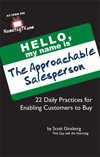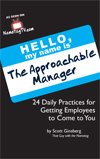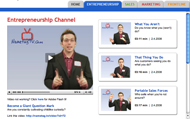 If you don’t have a “real” job, keep reading.
If you don’t have a “real” job, keep reading.
Because one the biggest challenges of being a solo practitioner, entrepreneur, independent contractor or self-employed spare-room-tycoon .. is the loneliness.
It sucks.
You have no coworkers, save your dog. You have no employees, save your spouse. And you have few local customers, or if you DO, you don’t see them that often.
Bummer.
You have nobody that’s going to make you get up in the morning. You have nobody that’s going to hold you accountable if you show up 20 minutes late. And you work out of your “home office,” which may or may not double as your living room, garage, basement or linen closet.
DOUBLE bummer.
So, what’s the solution?
THREE WORDS: The Hangout Factor
It’s part marketing, part networking, part positioning, and ALL self-discipline.
As a writer, speaker, coach and entrepreneur, I’ve incorporated this strategy into my business for about seven years now. And I must say, it’s one of the smartest, most lucrative, and most FUN practices I’ve ever implemented.
Here’s what you do:
1. Identity Your Hangout. Find a local coffee shop, restaurant or public meeting place. Consider it your Annex. Choose one that has high traffic, great atmosphere, solid snacks/drinks, wifi and accessible outlets. Be sure to pick a place close to your neighborhood.
Be sure to pick a place that’s rich in creative stimuli. And, make sure your hangout resides in a somewhat centralized location where other businesspeople like yourself might frequent. Where do businesspeople “meet for coffee” in your neighborhood?
2. Plan your schedule. Early birds will show up when the store opens at six or seven, which is a great way to secure the same spot everyday. On the other hand, you may prefer mid-morning or lunch for the highest traffic. Me? I used to go super early in the morning, but now I prefer the afternoon when it’s quiet, yet steady.
Also, don’t overlook the possibility of hanging out during dinner or evening time. You probably won’t get the same type of crowd, so it all depends on what type of business you run and what type of people you hope to meet. What’s your best hangout time?
3. Be busy, yet available. Set up shop with your materials, laptop, iPhone etc. Know what you want to accomplish that day. Remember to stay on task – you’re there to work! Still, remember build in time for regular breaks. Wander around and see who else is there.
My speaker/coaching colleague Richard Avdoian, veteran practitioner of The Hangout Factor says, “Versus the hard-sell or always being the initiator conversation, you build ease and comfort that invites others to approach YOU.”
Now, remember, while productivity is important, part of the reason you implement The Hangout Factor is for networking purposes. So, set a boundary. Be approachable, yet discerning. Are you so busy at your hangout that people are hesitant to approach you? How many relationship opportunities are you missing by wearing headphones?
4. Come prepared. If you’re an artist, bring examples of your work. If you’re a salesperson, have order forms ready to go. If you’re an entrepreneur, have samples of your products in your bag. And of course, always have business cards and other tools in your networking arsenal at your disposal.
Now, that doesn’t mean parade your products around the store like a walking trade show booth. And there’s no reason to over self-promote. Just be ready. You never know. As Avdoian suggested to me when I first started my business, “Through slow, subtle exposure, you create a real presence, yet in a passive way.” Are you ready to pitch at a moment’s notice? What if someone asks for a copy of your book?
5. Reinforce your regularity. Let’s say you decide to hang out at Starbucks, every morning, from 8-11. Cool. So, whenever you meet a new friend at your hangout, always remind them, “Well, I’m usually here most mornings. Feel free to come over and say hey!” Also, when you see people outside of your hangout, let them know where you hang out. “Yeah, you can usually find me over at the Starbucks at Hanley & Wydown most mornings. Stop by some time…”
This makes your presence public, plus keeps you accountable with the knowledge that people will be keeping an eye out for you. The ultimate goal is to cause people to say, “Yeah, I hear he hangs out at that Starbucks a lot…” Who knows where you hang out? Are they going out of their way to come and see you? What if you’re not there that morning?
6. Maintain the right attitude. Lastly, be sure your behaviors don’t reflect the wrong kind of attitude. Over the years, I’ve watched hundreds of people practice The Hangout Factor unsuccessfully. It’s so obvious too. They sell too much. They talk too much. They don’t have fun. They don’t honor other people’s boundaries or respect their time.
Conversely, sometimes people do the opposite. They talk too little. They don’t approach anybody. They bury their nose in their work, headphones in place, creating a wall over which most people aren’t interesting in climbing. So, it’s about finding the right balance for you.
My suggestion: Just relax. Just be cool. It’s called a “hangout” for a reason. So, don’t telegraph neediness. Don’t be flaky. You don’t need to say hi to everybody. You don’t need to give a business card to every person that walks past your table. Just be cool. What do your behaviors broadcast about your attitude?
OK! Now that you’ve seen how The Hangout Factor works, here are ten reminders WHY this strategy is important to you as a solo-practitioner.
1. Visibility. Anonymity is bankruptcy. Anonymity is your greatest barrier to business success. It’s time to stop winking in the dark and start getting visible. And you can only be SO successful if you never leave the house.
So, going to Panera every morning, for example, is a great way to position yourself as a friendly person, a loyal customer, a hard worker and someone who values his community. Plus the French Toast Bagels are ree-diculous. Who knows YOU? What do they know you AS?
2. Daily Appointments. Ever since starting my business at the age of 22, I’ve spent anywhere from fifteen minutes to one hour every single day having a Daily Appointment with Myself. I’ve probably missed ten appointments in seven yeas. And, in my books and speeches, I cite this practice as the absolute, number one, 100% smartest daily practice I’ve ever done in my life, ever EVER.
So, I challenge you to use some of your time at your hangout for your Daily Appointment. How much time do you spend each day just thinking? Are you treating yourself as the most important person in the world?
3. Discipline. Not that you should regiment and routine your days TOO much, but The Hangout Factor will help train your entrepreneurial mind and body. This discipline will eventually become an inseparable part of you and translate into other domains of your life and business.
During the first few years of daily trips to my hangout, I slowly built a strong enough foundation of discipline that it eventually carried over to my writing, exercise and mediation routines. Now I start work at 4 AM every day, no problem. It’s amazing what forcing yourself to be at the same coffee shop at the same time every morning will do for you. What are your non-negotiables? What’s the one ritual you can’t do without?
4. Accountability. Because you don’t have a real job, establishing a specific, consistent hangout regimen will almost force you to show up. That’s always been my favorite part – the sense of purpose you feel. Like you actually have to BE somewhere, as opposed to going from your bed to your shower to your couch.
And if you miss a day, it’s not like the chef is going to storm out from behind the oven to yell at you for being absent. (Although that DID happen to me once.) Still, there IS something to be said about public accountability. It’s like painting yourself into a good corner. Who’s keeping you on task? Who’s kicking your butt?
5. Social Interaction. Once The Hangout Factor becomes a part of your regular schedule, a few immediate patterns start to show up. You meet the other regulars. You get to know the staff. You start seeing people you know pass through. And, you meet new people, too.
So the best part is, all of these encounters combined nourish the part of your self-employed soul that becomes deprived without human interaction.
See, we need connection. We need engagement. We need to touch other human beings. It’s healthy. It affirms your self-worth. It sustains your business. And this is kind of hard to do when you spend most days sitting in your living room, pounding away on your laptop, still wearing your Hello Kitty pajamas as the mid-afternoon sun starts to set. How late did you sleep yesterday? How many times did you leave the house last week?
6. Informing your work. Getting out of the house and into the world is crucial component to supporting, enriching, inspiring and informing your work.
You share ideas, when you bounce them off others for feedback.
You get ideas, as the raw material for your work is everywhere.
You round out ideas, as new experiences add fresh dimensions to existing thoughts.
You change your scenery, which alters your routines and patterns, which stimulates creativity.
Lastly, you become more relatable, infusing a spirit of humanness and ordinariness in your work; created by someone who, himself, is human and ordinary because spends time with OTHER ordinary humans in ordinary places doing ordinary things.
After all, it’s hard to run a business in a vacuum. And your Pit Bull, as sweet as she is, probably isn’t the best focus group for testing our your new company tagline. What inspires your work? How have you allowed your surroundings to fill in the holes of your ideas?
7. Curiosity. If you hang out at the same place – and sit in the same spot – every single day, after a few months, here’s what will happen. Other regulars (and probably some employees, too) will start to approach you out of a sheer curiosity about what you do, who you are, what your deal is. And you will happily tell them!
For example, when I’m at my hangout, I often spread dozens of colored content notecards across the table. This is my unique process for creating modules for upcoming books, speeches, coaching programs and NametagTV episodes. And what’s cool is that (1) everyone notices it, (2) many people watch it curiously, and (3) some people even come over and ask me about it.
See! You don’t need a nametag to be approachable. The Hangout Factor is about repeated impressions and stimulating interest. How are you creating a Point of Dissonance? Who’s coming up to just to find out what YOU’RE doing?
8. DUH! Think about it: If you planned on spending the next three hours checking email, working on proposals, designing a new website or doing simple online work, why stay at home? You may as well be public, be visible and be out there. It could only increase your chances.
That’s what’s great about Hangout Marketing. Remember, L.U.C.K. is an acronym for “Working Your Ass Off.” And if you want to be in the right place at the right time, you need to be in a lot of places. In the words of my favorite songwriter, Glen Phillips, “There is nothing that doesn’t matter. Every word is a seed that scatters. Everything matters.” How many seeds did YOU scatter this week?
9. Intentional Discomfort. Your success as a small businessperson is a function of your willingness to BE – and the amount of time you spend IN – your zone of discomfort. That’s where the learning occurs. That’s where the good stuff happens.
The barrier is that too many of us overlook a strategy like The Hangout Factor because we’re afraid of being out of our element. We’re afraid of not being in control, not being “on stage,” like we would be in a conference room or normal office.
Well, here’s the reality: You can’t choreograph everything. You’ve GOT to embrace unpredictability. That’s what “sticking yourself out there” is all about. The challenge, then, is to intentionally put yourself in situations where you can practice being yourself. Enter into environments that almost FORCE you to practice being natural and human.
After all, that’s the kind of person customers want to do business with. Because people buy people first. How did you step out of your comfort zone yesterday? What five lessons did you learn from that experience?
10. Opportunity. Because you never know. Everybody is somebody’s somebody. So, think of The Hangout Factor as a simple solution for exponentially increasing your activity level. In my experience, I’ve secured coaching clients, made friends, even scored interviews with local media outlets because of the people I’ve met at my hangout.
Also, let us not forget the intangible value. The resulting opportunities you’re never aware of. Colleagues of mine who (also) don’t have real jobs have netted results in the neighborhood of $20,000 of new business, just from practicing this strategy! I wonder what would happen if you started doing it. How many friends did you make today? How many places are YOU in?
OK! Let’s recap two facets of The Hangout Factor.
FIRST, HOW TO DO IT: Identity Your Hangout. Plan your schedule. Be busy, yet available. Come prepared. Reinforce your regularity. Maintain the right attitude.
SECOND, WHY YOU DO IT: Visibility. Daily Appointments. Discipline. Accountability. Social Interaction. Informing your work. Curiosity. Activity Level. Intentional Discomfort. Opportunity.
Got it? Ready to start hanging out?
Cool. Good luck to ya. And if you need me, I’ll be at the Bread Company on Brentwood with a bunch of colored note cards and a bowl of French Onion Soup.
LET ME ASK YA THIS…
What’s YOUR hangout?
LET ME SUGGEST THIS…
For the list called, “7 Ways to Out ATTRACT Your Competition,” send an email to me, and I’ll send you the list for free!
* * * *
Scott Ginsberg
That Guy with the Nametag
Author, Speaker, Coach, Entrepreneur
[email protected]
 How many sales have you lost because you weren’t approachable?
How many sales have you lost because you weren’t approachable?
Buy Scott’s new book and learn how to sell enable people to buy!
Pick up your copy (or a case!) right here.

 1. Develop burning desire. You have to be on fire or else you will not succeed. You have to sustain an undousable flame in your belly or else you will not survive the cruelty that naturally gravitates to those who boldly venture out of their wussy little boxes. Are you on fire yet?
1. Develop burning desire. You have to be on fire or else you will not succeed. You have to sustain an undousable flame in your belly or else you will not survive the cruelty that naturally gravitates to those who boldly venture out of their wussy little boxes. Are you on fire yet?
 1,400.
1,400.


 FACT: If you’re a writer and you’re using Oprah as an example of “effective personal branding,” you’re not a very creative writer.
FACT: If you’re a writer and you’re using Oprah as an example of “effective personal branding,” you’re not a very creative writer. What did you used to build as a kid?
What did you used to build as a kid?
 If you want to learn a LOT about someone quickly, just ask that person to take you through her daily routine.
If you want to learn a LOT about someone quickly, just ask that person to take you through her daily routine. 
 In ONE word: Relax.
In ONE word: Relax. Ahhhhh…!
Ahhhhh…! Writing might be the single most important act anyone could practice.
Writing might be the single most important act anyone could practice.